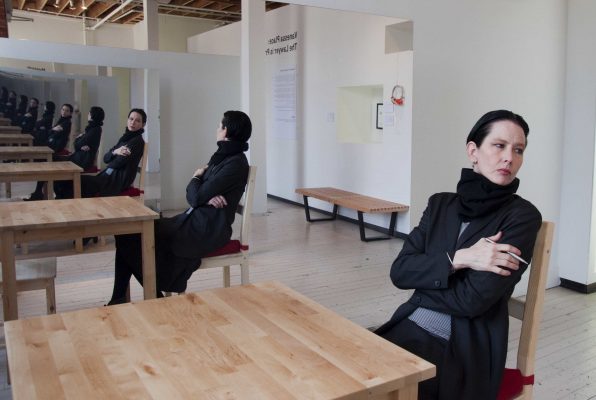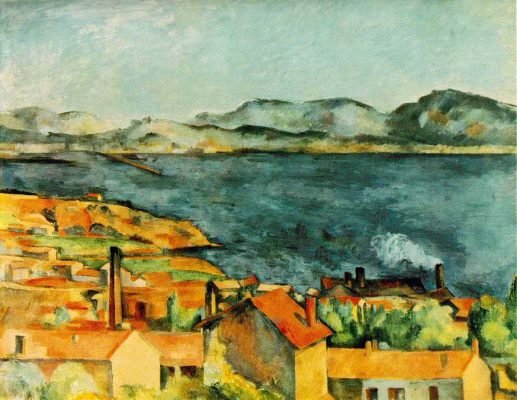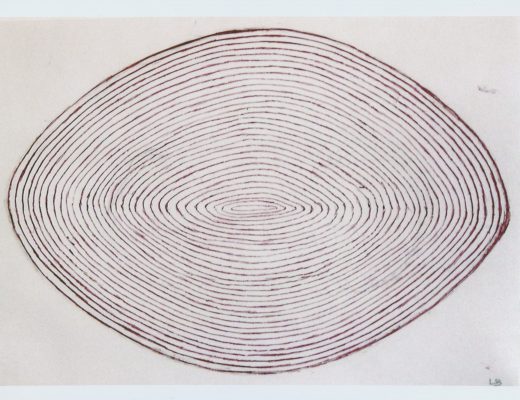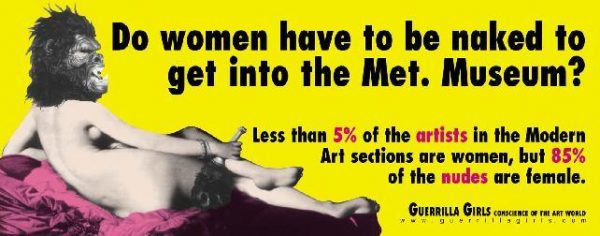Here are a few of the Joans I know. The girl who arrives at Port Authority Bus Terminal in New York feeling uneasy about her dress. The woman who rubs an ice cube against her lower back in a hotel room with a broken air-conditioning unit. The journalist who turns down acid offered to her by an interviewee. When I think of Joan Didion, I think of a packing list for a reporting trip that included bourbon and two skirts. And then the story of her husband reading her own book to her, cover to cover, as a birthday gift.
Of course, I don’t know Joan Didion at all. She renders these images from her life so vividly, but then with sleight of hand she manages to obscure herself. What is Joan Didion like at a party? Does she move her hands as she speaks? Is she reserved? Funny? How did she act as a wife, as a mom?
There’s a tendency to adopt a lofty tone when addressing Didion’s career. Presenting her with the National Humanities Medal in 2012, Barack Obama called her ‘one of the most celebrated writers of her generation … one of our sharpest, most respected observers of American politics and culture.’ Then, to lighten the mood, the President added, ‘I’m surprised she hasn’t already gotten this award.’ His joke was greeted with muffled laughter.
Most of Didion’s writing is not autobiographical. She’s written five novels and nine screenplays; her political journalism has covered American involvement in El Salvador, Cuban exiles in Miami, the Bush and Clinton administrations. The spectre of her great celebrity, however, derives from her personal writing. But since there is no tell-all autobiography in her oeuvre, no David Copperfield-esque narrative to detail specific motivations for specific events, her readers are left to parse out a timeline for themselves. They have a few particular books from which to cull.
Didion’s most recent books, Year of Magical Thinking and Blue Nights, recount her grief and loss following the deaths of her husband and daughter. They are arguably her most revealing works. But the classic fan-favourites are Slouching Towards Bethlehem and The White Album, essay collections written in the 1960s and ’70s, where personal essays are scattered amongst her early reportage and criticism. Readers’ widespread romanticisation of Didion is rooted in these books, which are peppered with references to silk dresses, bourbon, jasmine, trips to Hawaii, the writer’s own youth, straightforward writing about anxiety. In the preface to Slouching Towards Bethlehem, she describes herself writing the book’s title essay, ‘I drank gin-and-hot-water to blunt the pain and took Dexedrine to blunt the gin.’ In The White Album, she publishes portions of her own psychiatric report, reprinting words like vertigo, nausea, alienated, distorted.
‘The candor frequently stuns,’ New York Times critic Michiko Kakutani wrote in her 1979 review of The White Album. Robert Graves, a former Life editor who worked with Didion, told the Times, ‘Joan gives everyone the impression of being very private. Then she’ll turn around and write this inside-of-the-stomach stuff that you’d think you’d need to know her five years to find out. This mousy, thin, quiet woman tells you as much about herself as Mailer.’
The candor seems less stunning now. More than fifty years after Slouching Towards Bethlehem and forty years after The White Album, a parade of other essayists have followed: Cat Marnell (‘I was very sick at the time and going through bad things and had missed my flight and shown up seven hours late due to an epic angel dust binge’), Lena Dunham (‘Sometimes, to manage the images that come unbidden, I force myself to picture my parents copulating in intricate patterns’), and Leslie Jamison (‘I used to cut. It embarrasses me to admit now, because it feels less like a demonstration of some pain I’ve suffered and more like an admission that I’ve wanted to hurt’). In the years since Didion began writing about herself, confessional writing has become standard, almost expected.
Didion’s work, in contrast, keeps pain at a distance. Her writing is so intimate, yet reveals little biography, few connectable facts. Instead, she offers a thousand glimpses into hotel rooms, bars, city streets. She doesn’t give herself over to her audience in the way that Marnell, Dunham, and Jamison do. No one could call her confessional. In a 2011 interview with The Believer, Didion said, ‘Somehow writing has always seemed to me to have an element of performance.’ Few authors ‘perform’ to such a large audience: Didion joins the ranks of a select group of writers whose celebrity rivals their writing. Their fans want to know them. Their homes become museums. Their cities host walking tours. Readers hold on to stories of these writers’ failed relationships and substance abuse issues.
She’s the rare literary celebrity who lives to see such overwhelming fame. And amazingly, no one has capitalised on this fame until now. Didion’s nephew, actor-director-producer Griffin Dunne, shares in this amazement. He’s working on a documentary about her life. As he says in his promotional video on the fundraising site Kickstarter, ‘We are making it because no one else, incredibly, has made a documentary about Joan Didion. It’s a mystery.’
His proposed documentary promises to give us access to the author: finally, a chance to get a little closer. Dunne points to an old family photo. ‘This is my aunt, Joan Didion Dunne. That is my uncle, John Gregory Dunne. That’s me. And I’m their nephew.’
He’s an insider. And he can help distinguish between Didion’s literary ‘performance’ and the real thing. ‘People don’t know what Joan sounds like when she talks. I think they should know,’ Dunne says. And so he takes it on as a personal duty.
It’s a funny business making a documentary about a memoirist. Griffin Dunne is enlisting in a line of work that Joan Didion has been doing for over fifty years—telling stories about Joan Didion. In fact, the documentary takes its name from the first sentence of The White Album: ‘We tell ourselves stories in order to live.’
‘This is a story I’m telling in order to live,’ Dunne says, with no apparent trace of irony. Here’s a proposition from Griffin Dunne: ‘Have you ever wanted to tell Joan what she truly means to you? How her writing changed you? Write a two page letter to Joan and her family will read the letter aloud to her.’ All for $350.
This proposal manages to pry into the internal life of both literary fan and writer. It takes advantage of the fan’s (assumed) desire for an emotional connection, while actively invading the author’s home life. (And why will Didion’s family be reading the letters aloud to her? Obviously, she’s literate. Does she have vision issues? Is it an assurance that Didion cannot just skim the letters—that she must, and will, receive the entire document?) Tellingly, only 18 of the 3,500 donors went for this prize.
Here’s another prize: for $2500, you can get ‘JOAN’S PERSONAL SUNGLASSES’. The website copy states, ‘What are one of the most iconic pairs of sunglasses a girl could own? This is your opportunity to see the world as Joan, with a pair of sunglasses from her personal collection. Domestic and international shipping included!’
Putting aside the fact that Griffin Dunne is literally selling off Joan Didion’s personal belongings, his language betrays quite a few gender assumptions about his film’s intended audience. Apparently, it’s a movie for girls—fashion-conscious girls who want to own a piece of their idol. Embedded in this offer is the suggestion that one could almost become Didion simply by owning her sunglasses. It’s a similar sort of thinking to that behind Selena Gomez’s perfume line, Jennifer Aniston’s endorsement deals with Aveeno and Smart Water, and the printing of Taylor Swift’s face on posters, T-shirts, and book bags. The French luxury brand Celine has recently cast Didion in their ads. Not surprisingly, Dunne is also commissioning Didion-themed T-shirts and tote bags.
In the video, Dunne continues courting what he supposes is Didion’s readership. He brings up the 1965 essay ‘On Morality’, which he calls ‘a handbook for so many women on how they want to live their lives.’ He must have a different understanding of the essay, or else a different understanding of handbooks. It is an essay that sneers at the word ‘morality’, that debates the word’s very definition.
The essay opens with an anecdote about a man waiting beside a corpse overnight in the desert. He’s there for a moral reason: so that coyotes cannot consume the body. Here, morality ‘meant something quite specific’; Didion, who usually finds the term deplorably vague, writes of this instance, ‘I did not distrust the word.’ By the end of the piece, Didion disputes the very existence of an intrinsic moral code, insisting that ‘we have no way of knowing—beyond that fundamental loyalty to the social code—what is “right” and what is “wrong”, what is “good” and what is “evil.”’
If ‘On Morality’ is a handbook, as Griffin Dunne calls it, it is one that castigates all familiar handbooks, that questions the very use of handbooks. And there is nothing in the essay that makes it specific to young women. His assumptions beg the blunt question: did Griffin Dunne not read ‘On Morality’, or did he just not get it?
Griffin Dunne’s (mis)understanding of Didion’s readers is reminiscent of a 2011 Atlantic article by Caitlin Flanagan, where she dismisses Didion fans as women stuck in a perpetual adolescence who have found their own girly Hunter S. Thompson. ‘Slouching Towards Bethlehem was our Fear and Loathing in Las Vegas. He gave the boys twisted pig-fuckers and quarts of tequila; she gave us quiet days in Malibu and flowers in our hair.’ Didion, herself, is fashioned into a sort of Barbie doll for those who have only recently outgrown Barbie dolls: ‘the mysterious girl-woman: sitting barelegged on the stone balustrade; posing behind the wheel of her yellow Corvette; wearing an elegant silk gown and staring off into space, all alone in a chic living room.’
Flanagan’s logic is exasperatingly circular. First she asserts, ‘To really love Joan Didion—to have been blown over by things like the smell of jasmine and the packing list she kept by her suitcase—you have to be female.’ And to back herself up, she writes that to not comprehend why women specifically love Didion is ‘to not know very much at all about those types of creatures.’
Flanagan is right about one thing: many of Didion’s readers and most ardent admirers are women. But women don’t love Didion because Didion is feminine. Women love Didion because Didion is taken seriously. Her writing is so strong, her observations so sharp, her prose so powerful that she transcends the ghetto of the female writer. She is ‘one of the most celebrated writers of her generation’, ‘one of our sharpest, most respected observers of American politics and culture’—and President Obama doesn’t go out of his way to mention that she’s a woman.
Didion’s own literary influences were men. She said in an interview with the Paris Review that as a teenager, she copied down Hemingway’s short stories in order to internalise his use of language (‘He taught me how sentences worked … perfect sentences. Very direct sentences, smooth rivers, clear water over granite, no sinkholes.’). She also cited Henry James (‘He wrote perfect sentences, too, but very indirect, very complicated. Sentences with sinkholes. You could drown in them.’). Yes, many of the details in Didion’s writing are stereotypically feminine: flowers and dresses are there, but they are not the point. Didion’s strengths lie in her powers of observation and her prose style.
To be clear, the Didion documentary is a work in progress. It’s impossible to form an opinion about the movie yet, because no one has actually seen it. All we have at the moment is a gesture from Griffin Dunne, a signal that a documentary is on its way. It is the gesture of an actor with little name-recognition making a movie about his more famous relative. It is the gesture of a wealthy man soliciting donations online. (Dunne’s great-grandfather, Dominick Francis Burns, founded the Park Street Trust Company.) It is also a gesture that feels unnecessarily morbid. Griffin Dunne calls his aunt ‘frail’ twice in the promo video, once while showing footage of her being helped onstage to stand with Obama. ‘When she’s not here, I will be’, Dunne later adds.
The documentary aims to chart Didion’s start as a staff writer at Vogue, her years screenwriting in Hollywood, and her lifelong career in journalism. Dunne promises us some gossip about her time in Los Angeles with her husband, fellow writer and collaborator John Gregory Dunne. ‘The centre of a very exciting time in cinema history, the Seventies,’ he says. ‘They were my aunt and uncle, but they were also probably the hippest people on earth.’ The promotional video uses the Ken Burns effect, panning over photos of the Central Park Five, Charles Manson, and Ronald Reagan. Dunne explains that old photos such as these, alongside archival video, will make up much of the documentary. He calls it a ‘collage’.
‘We want to do the interviews with the people who have worked with her, have known her,’ Dunne narrates over photos of Anna Wintour and Annie Leibovitz, ‘and the people who have been influenced by her,’ he continues as, puzzlingly, a headshot of Rob Lowe flashes onscreen. None of these are famously close to Didion. Leibovitz has photographed her. Wintour and Didion are connected through Vogue. For his part, Rob Lowe pointed out a tenuous connection to Didion in a 2014 interview on Oprah.com. ‘Incidentally, she was one of the local moms when I was growing up in Point Dume.’ He goes on: ‘She always reminded me a little bit of my mother, so I feel a great affinity.’
The promotional video features several family photos. Here are Didion and her husband standing on either side of their daughter Quintana on her wedding day. Here’s baby Quintana sitting on Didion’s lap. Here’s Quintana with her mouth agape, about to bite into a popsicle. Her dad is standing next to her, holding another popsicle that’s already half eaten. And Didion is standing closest to the camera, almost looming over it. She stares into the lens from behind dramatic sunglasses. ‘We also want to show her for the mother, the wife she is,’ Griffin Dunne says.
And so here it is. The promise that now you can know her. Really know her. And Griffin Dunne is just that someone to help you parse through the many Joans. There is the Joan who writes, ‘I am talking here about being a child of my time’. Then the Joan who writes, ‘I had better tell you where I am, and why’. The Joan of ‘I want you to know, as you read me, precisely who I am and where I am and what is on my mind’. And, of course, the Joan who writes, baldly teasing her reader, ‘I tell what some would call lies.’
Didion goes on to corroborate her assertion that she lies. ‘“That’s simply not true,” the members of my family frequently tell me when they come against my memory of a shared event,’ she writes. ‘Very likely they are right, for not only have I always had trouble distinguishing between what happened and what merely might have happened, but I remain unconvinced that the distinction, for my purposes, matters.’
It’s a sly move. The unreliable narrator confesses to lying, confesses to not even separating real memories from false ones. And then she goes on to say that she doesn’t care. In doing so, she leaves a wide opening for a documentary with claims to tell it as really it was.
‘When you donate, you are proving that there is a huge, hungry audience for a documentary about Joan Didion,’ Griffin Dunne says. And he is proven right. He asked for $80,000 on Kickstarter and received more than $220,000. ‘We were flabbergasted by the love and dollars and cents that came flooding in from all over the world,’ he told Variety magazine.
Of course, this documentary has strong appeal for Didion’s readers. Finally, a perspective on Didion that is not her own. Maybe the documentary will include some unflattering-yet-true stuff that Didion herself would not have chosen to broadcast. Maybe it will afford her moments of grandeur that Didion would never allow herself in her own writing. ‘We Tell Ourselves Stories In Order To Live’ could be a trashy hit piece or a fluffy bit of hagiography or something clear-eyed and even-handed and truthful—it could be any number of things. Documentary takes all these different forms.
And this documentary, in particular, offers a way to pin Didion down. Because in her own writing, she isn’t one: she is many. She creates several Joans, contradictory voices, a split identity from which candor sometimes leaks through. In this definitive documentary about his ‘Aunt Joan’, Griffin Dunne’s exclusivity gives us an opening for a refreshingly reductive portrait. Now she can be one. A reified Joan Didion that we can understand, visualise, wear on a T-shirt.
The documentary takes pains to assert Didion’s active role in the film. The website states several times, as a sort of refrain, ‘Made with Joan, using Joan’s words.’ At the end of his promotional video, there’s tape of Griffin Dunne sitting next to Didion in what seems to be a candid moment. ‘Take your time,’ he says to her, pointing to a camera offscreen. ‘“We tell ourselves stories in order to live.” Right into the lens.’ And Didion seems willing. She points to confirm the correct camera.
It’s unclear how Didion will be involved onscreen, apart from reading her own work. While there will be several interviews with high-profile outsiders, Griffin Dunne has not stated that Didion will speak about herself. It’s a key difference: whether Didion will be the object or the subject of this documentary, whether she will give anything of herself to the film that goes beyond her own writing.
And no one knows better than Didion just how much power she is giving over to Griffin Dunne by participating in this movie. She wrote about her relationships with her own interviewees in the preface of Slouching Towards Bethlehem: ‘People tend to forget that my presence runs counter to their best interests. And it always does. That is one last thing to remember: writers are always selling somebody out.’
At the time, she was not even referring to Griffin Dunne literally selling off her possessions. She was talking about the act of imposing a narrative over someone else’s life. In this case, imposing a narrative over the parts of her life that she could have written about, but chose not to.
The documentary’s Instagram account features one of the most recognisable photos of Joan Didion, taken by Julian Wasser in 1968. She’s posing in her Corvette. Her small frame is emphasised by the vehicle’s bulk. One arm dangles out of the car window. In this particular photograph, a tote bag has been Photoshopped into the picture. It’s positioned to hang down from Didion’s outstretched hand. The bag’s yellow and pink detailing pops on the grainy black and white film stock.
A note in the photo’s caption reads: ‘ATTN! My uncle, Roman’s @pacifictotecompany Play It As It Lays inspired bags are now available on the didion doc kickstarter. There’s only 30!! –g’
It’s a metaphor that’s just a little too neat. Limited edition, Didion-themed merchandise pasted onto a familiar image of the writer. Old meets new. Something enduring and something for sale.
‘This should be a meme!’ one commenter has written under the Instagram photo.
‘I just donated and the tote is already my most prized possession,’ another has added.




